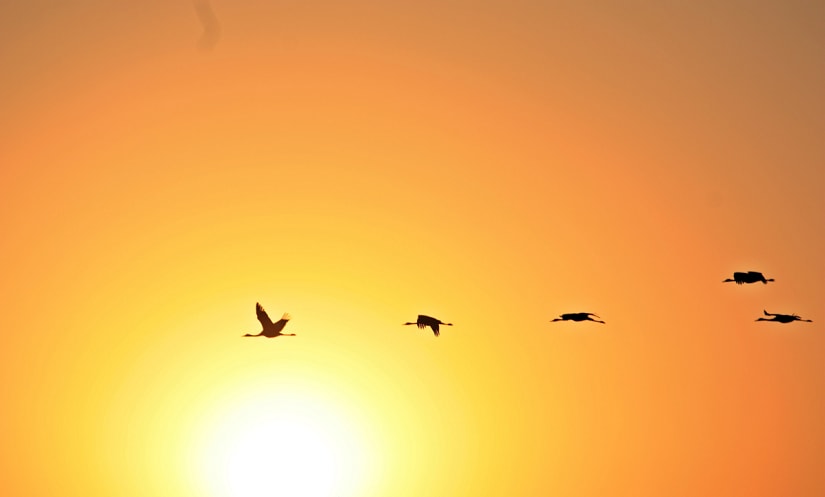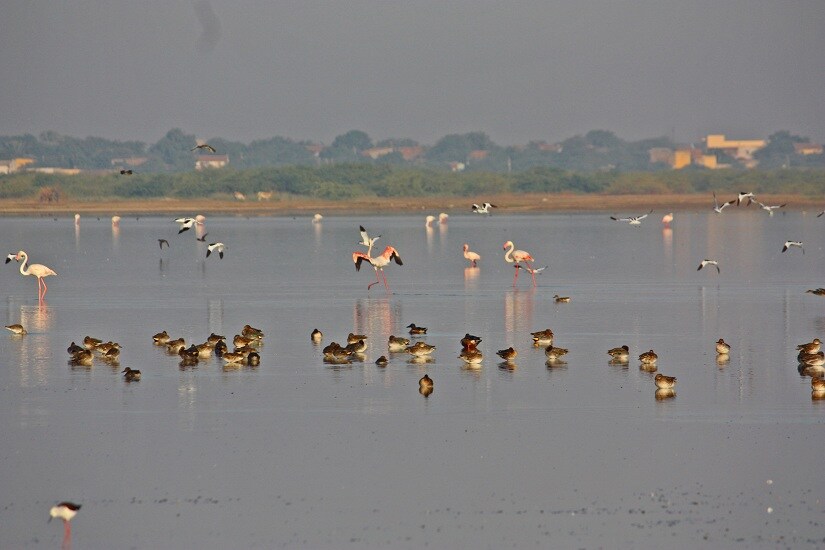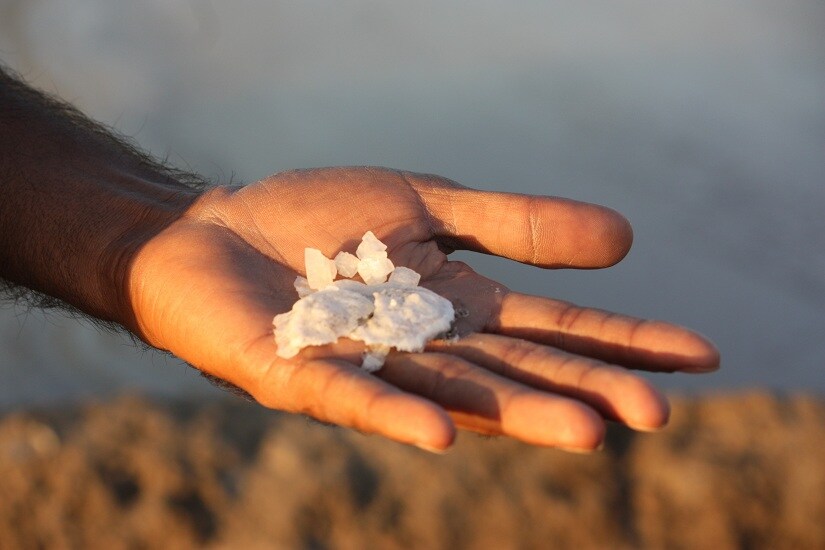The conflict brewing in Little Rann highlights that getting the balancing act right between wildlife-and-people is one of the great challenges that India will need to solve
Editor’s note: From May 2017, Firstpost is featuring a fortnightly column by Mridula Ramesh, titled ‘Climate Conversations’. In this column, we take a look at pressing issues pertaining to climate change — in an accessible way. The Rann is unlike any other place on Earth that I have seen. Cracked, parched earth stretching as far as the eye can see.
Summer temperatures reach 50°C. There are no trees we saw to provide shade, only a few shrubs that occasionally dot the landscape. Every year, the monsoon floods the Little Rann, covering the land with fresh and sea water. The Little Rann is also fed by seasonal rivers like the
Banas and the Saraswati. As the waters recede, the land dries and cracks by October. This seasonal interplay of salt and fresh water defines the land. [caption id=“attachment_4399789” align=“alignnone” width=“825”]
 Geese flying across the setting sun, Little Rann. All photos courtesy Mridula Ramesh[/caption] Life here survives in the margins. At some level, the sheer exuberance of life in the Rann underlines the unfailing, adaptive capacity of life. A shimmering mirage in the horizon became a lake. In the morning sun, ducks lazed and groomed themselves near the shore, while geese flew overhead. Further in, a flamingo decided to dance, spreading black-tipped fuchsia wings. In the horizon, beyond the lake, buildings were visible — a great reminder of how ‘hemmed in’ our wildlife is. [caption id=“attachment_4399799” align=“alignnone” width=“825”]
 Birds in the morning, Little Rann[/caption]
![IMG_1961]()
The Little Rann is the only home of the Great Indian Wild Ass. This beautiful animal looks like someone dipped a donkey in creamy, white paint, dabbed a lovely, light brown on parts of its upper half, and added a fringe of dark brown hair. Stringent conservation efforts have caused a tremendous growth in the Wild Ass poulation, with current numbers pegged at
over 4,000 animals. Besides the Wild Ass, the Little Rann is home to several species of birds, the Nilgai (a large Indian antelope), Hyena and wild pigs. [caption id=“attachment_4399805” align=“alignnone” width=“825”]
 The Great Indian Wild Ass, Little Rann[/caption] The rise in wildlife population has meant a rise in conflict as well. Farms border the Little Rann, and better irrigation has meant more crops and cash crops.
Growing ass (and other wildlife) populations has meant the Wild Ass (and the Nilgai and wild pig) strays outside the sanctuary to feed on the crops. Naturally, the villagers are
unhappy. [caption id=“attachment_4399809” align=“alignnone” width=“825”]
 Nilgai, Little Rann[/caption] There is another narrative as well. The Little Rann supplies India with a
third of its salt. Salt making is a serious — and seriously uncomfortable — business. The Agariyas, about 40,000 of them, are the nomadic, expert salt farmers of the Little Rann, move into the Rann in October after the monsoon. They build tiny isolated huts of jute bags draped over bamboo sticks, next to the salt pans. They prepare the square pans carefully, ensuring the bed is hard — so the soil does not mix with the salt — by tapping the ground with their feet. Some believe that the salt leaches into their feet so much that when their bodies are cremated, their legs don’t burn and have to be buried separately. Then they dig wells and pump out the highly salty underground water using diesel gensets into these salt pans to evaporate. [caption id=“attachment_4399815” align=“alignnone” width=“825”]
 Salt Pan, Little Rann[/caption] They live in these lonely huts for months — the children go to some form of makeshift school, if at all, in a nearby village several kilometres away. They finally return to their villages in May, as the temperatures touch 50°C. The only potable water they have comes from the government tanker that delivers water periodically. To the Agariyas, ‘Day Zero’ of Cape Town must seem like heaven. [caption id=“attachment_4399817” align=“alignnone” width=“825”]
 Agariya Hut in Little Rann[/caption] Salt making is not lucrative. The Agrariya takes a loan from the trader at prohibitive rates at the start of the season. He uses that to buy fuel to run the diesel genset and food for his family. Though this was not mentioned by the Agariya family we met, this contract also
involves pre-booking of his salt production, at low rates. The Agariyas get about
20 paise per kilogram of salt. Compare this to the retail price which hovers around
Rs 17 per kilo. One innovation that is making a big difference to the lonely lives of these salt farmers is the introduction of the
solar powered pump which, by cutting down diesel costs, allows them to reap a far better return for their labour. How sustainable it is to pump out ever-increasing quantities of brine is an open question. Another is the impact of mechanisation and automation, which makes the economics of salt farming progressively worse. [caption id=“attachment_4399819” align=“alignnone” width=“825”]
 All for salt. Little Rann[/caption] As we drove away in the setting sun from the Agariya hut, I couldn’t help but reflect on the life of the Agariya woman with whom I had shared a delicious glass of aromatic black tea: Poor, isolated, harsh. It was likely to get harsher. Forest officials want the Agariyas to move out, saying the salt collection and transport interfere with the mating behaviour of the wild ass. The Agariyas and the NGOs who work with them disagree. The Agariyas (and other fishing and herding communities) want seasonal community user rights under the Forest Rights Act. On the other hand, there are sound arguments to be made to leave wildlife well alone — away from people, roads, factories, dams, mines and tourism. The world does not operate in black-and-white. How should we think of a compromise? Could we see if the income of people who share the sanctuary with wildlife can be supplemented by the presence of that wildlife? Especially if sustainable behaviour is reinforced constantly (as in the case of
the BRT reserve )? Artisanal salt sells for about
Rs 1,200 per kilo. Would a potential solution involve a greater focus on branding and quality rather than quantity? Or, is this form of precarious living doomed — not just for the Agariyas in the Little Rann Sanctuary but for other populations in other wildlife pockets? Where, then, would these populations go? In the last few days, the world released
the Happiness Report. Six variables — GDP per capita, social support, healthy life expectancy, social freedom, generosity, and absence of corruption — explain external factors determining why one is happy or not. Interestingly, a chapter on rural migrants in China, showed that rural populations were happier than urban populations despite having a household per capita income that was two-thirds less than their urban counterparts. Even more interestingly, rural migrants were the unhappiest of the three (rural/urban/migrant) — even though they were economically better off than their rural cousins. But the study appears to suggest that happiness requires a relatively steady income (future expectations of rising income are strongly correlated to happiness) – it is unclear if the Agariyas (or other tribal dwellers in forest) can achieve that even if the spirit of the Forest Rights Act was enforced. Also, this is assuming outside interests do not violate the spirit (of the act) and make the whole exercise one of land-grabbing. Even if there were jobs available in cities (and its not clear that there are), would tribal populations be ‘happier’ moving there? The report’s conclusion does not suggest that they might be. There is also climate change to consider. Our biodiversity is going to be hit hard by a warmer and more temperamental climate. Unsullied wildlife reserves are a
great way to build resilience — not just for the wildlife, but for all the ecosystem services that these reserves provide. Almost every peninsular river in India originates from a forest — important to keep in mind, in a world where water is getting scarcer by the day. Which just makes getting the balancing act right between wildlife-and-people, one of the great challenges that India will need to solve. The writer is the founder of the Sundaram Climate Institute, cleantech angel investor, teacher and author of a forthcoming book on Climate Change and India. Follow her work on her
website; on
Twitter; or write to her at
cc@climaction.net


)
)
)
)
)
)
)
)
)



